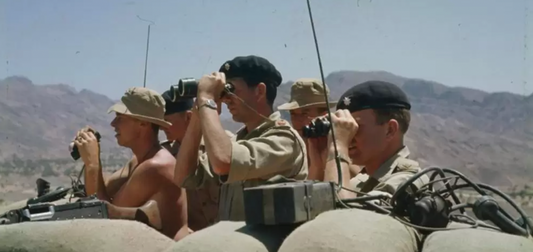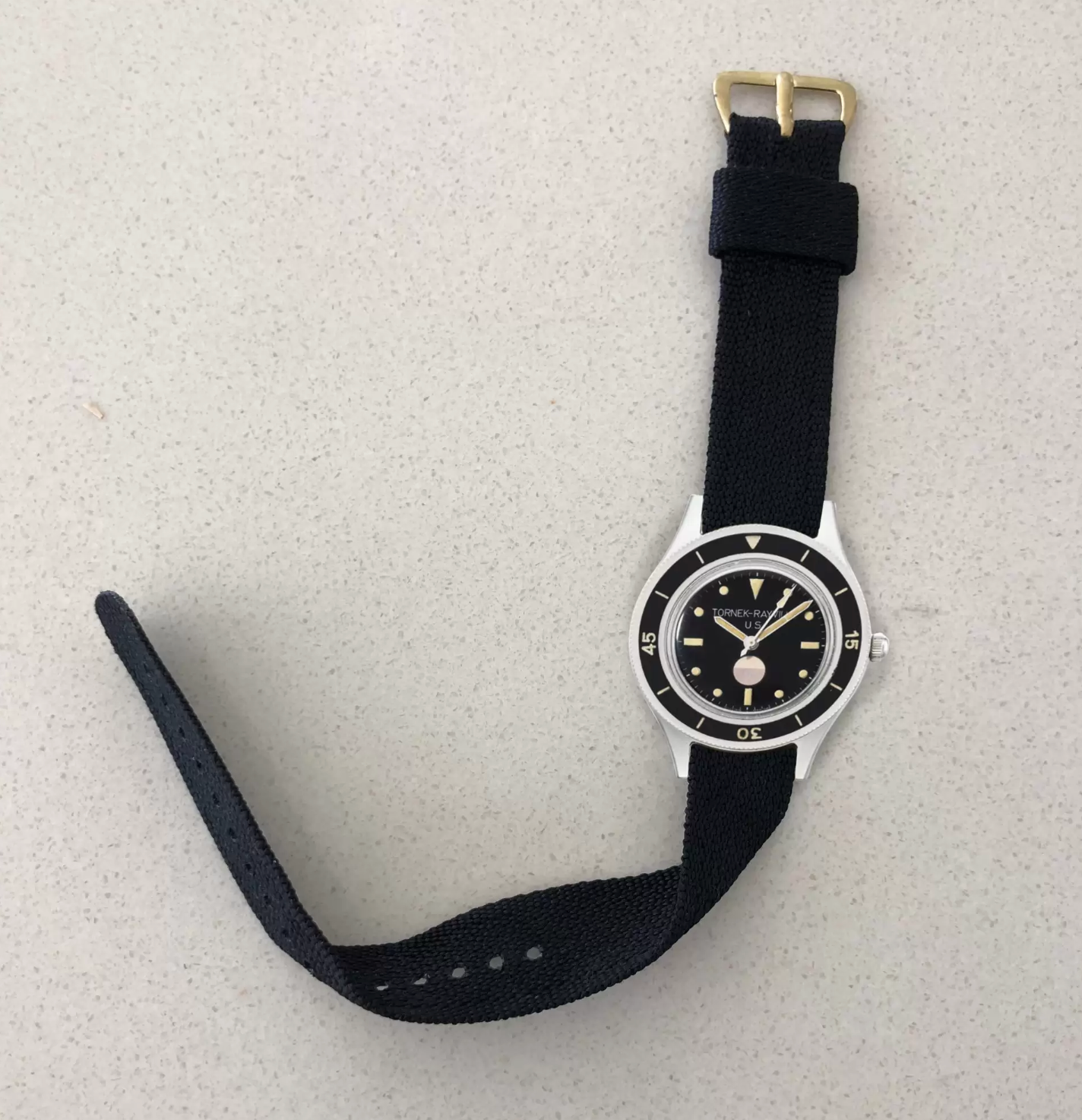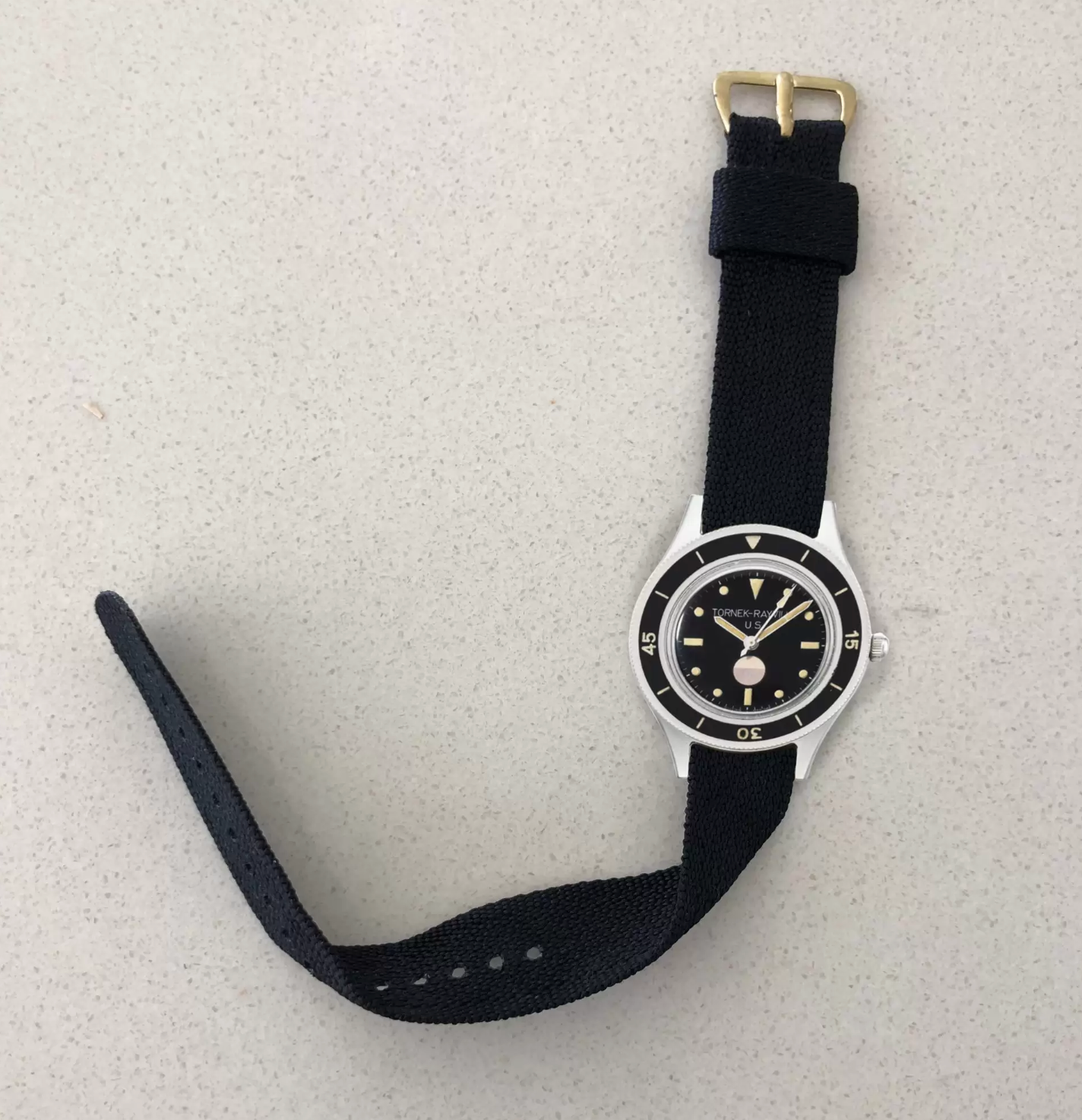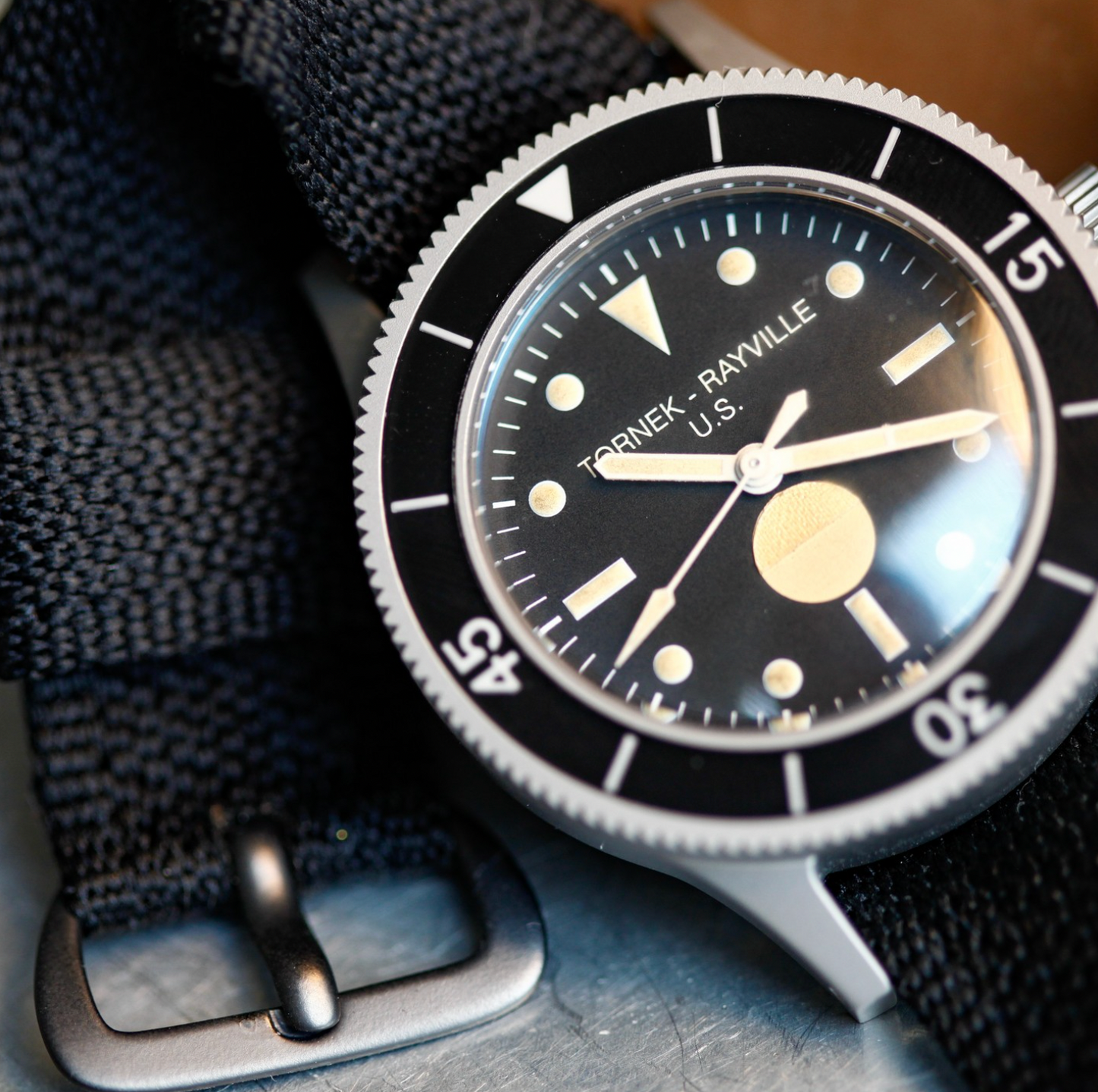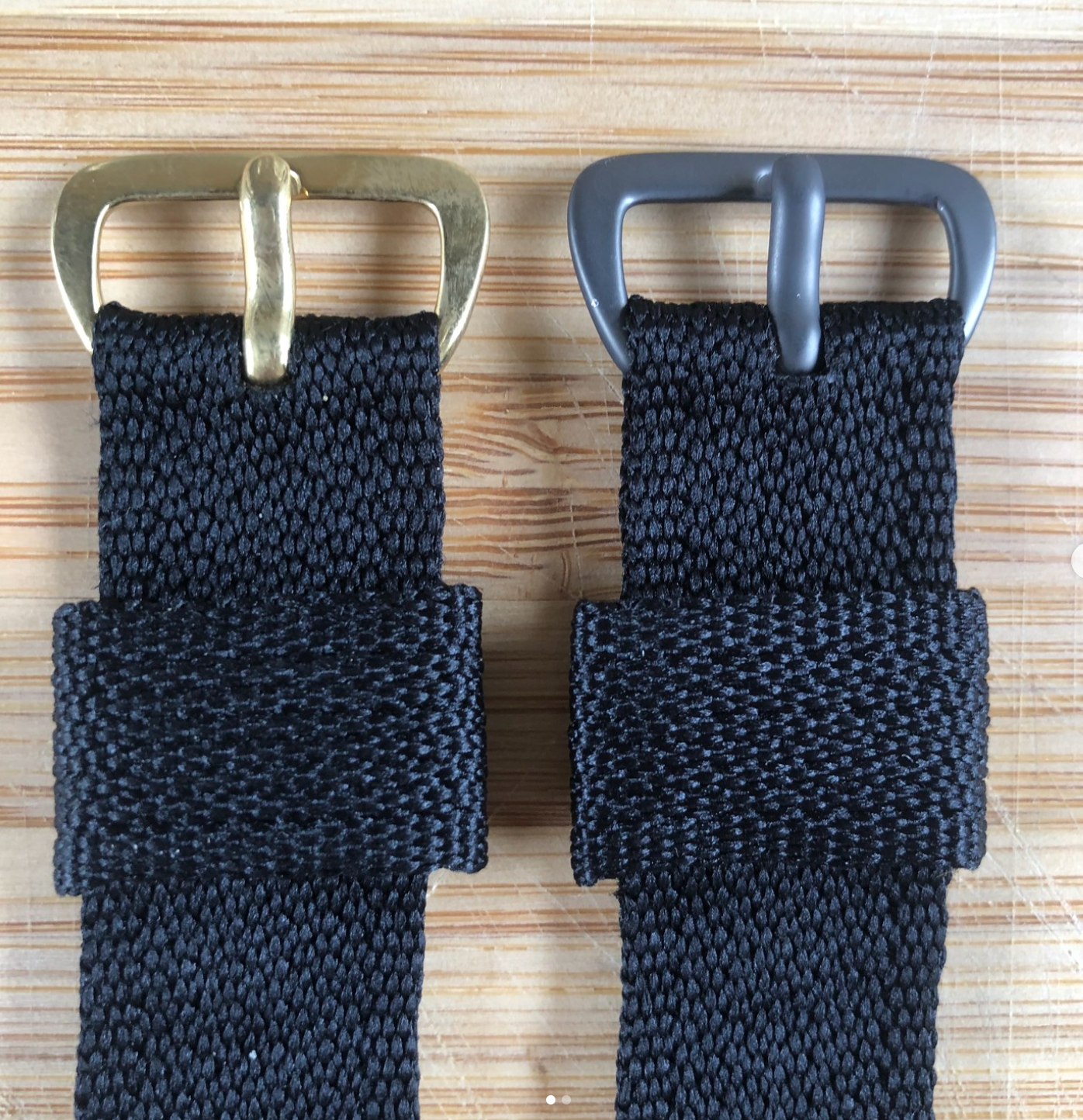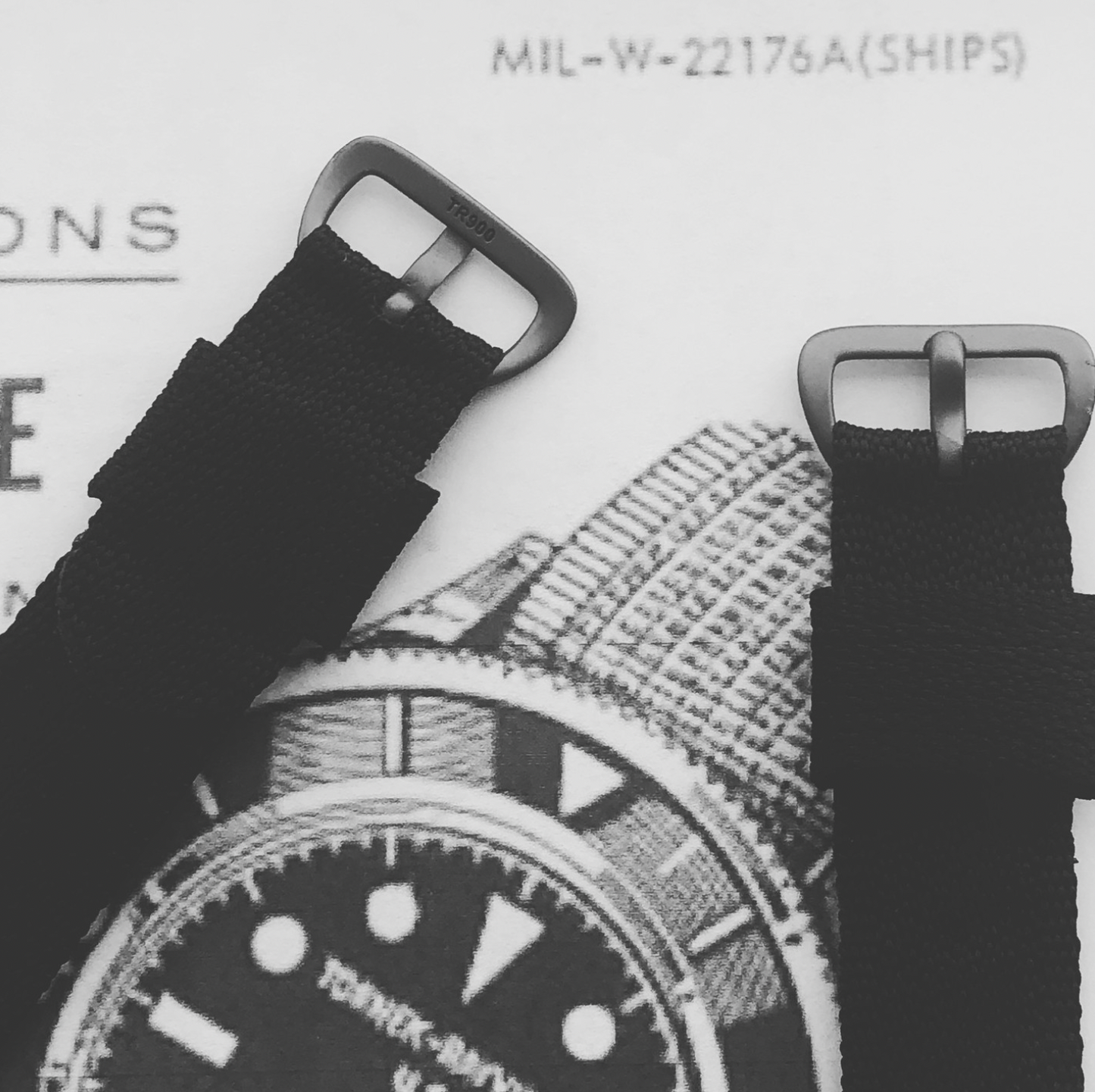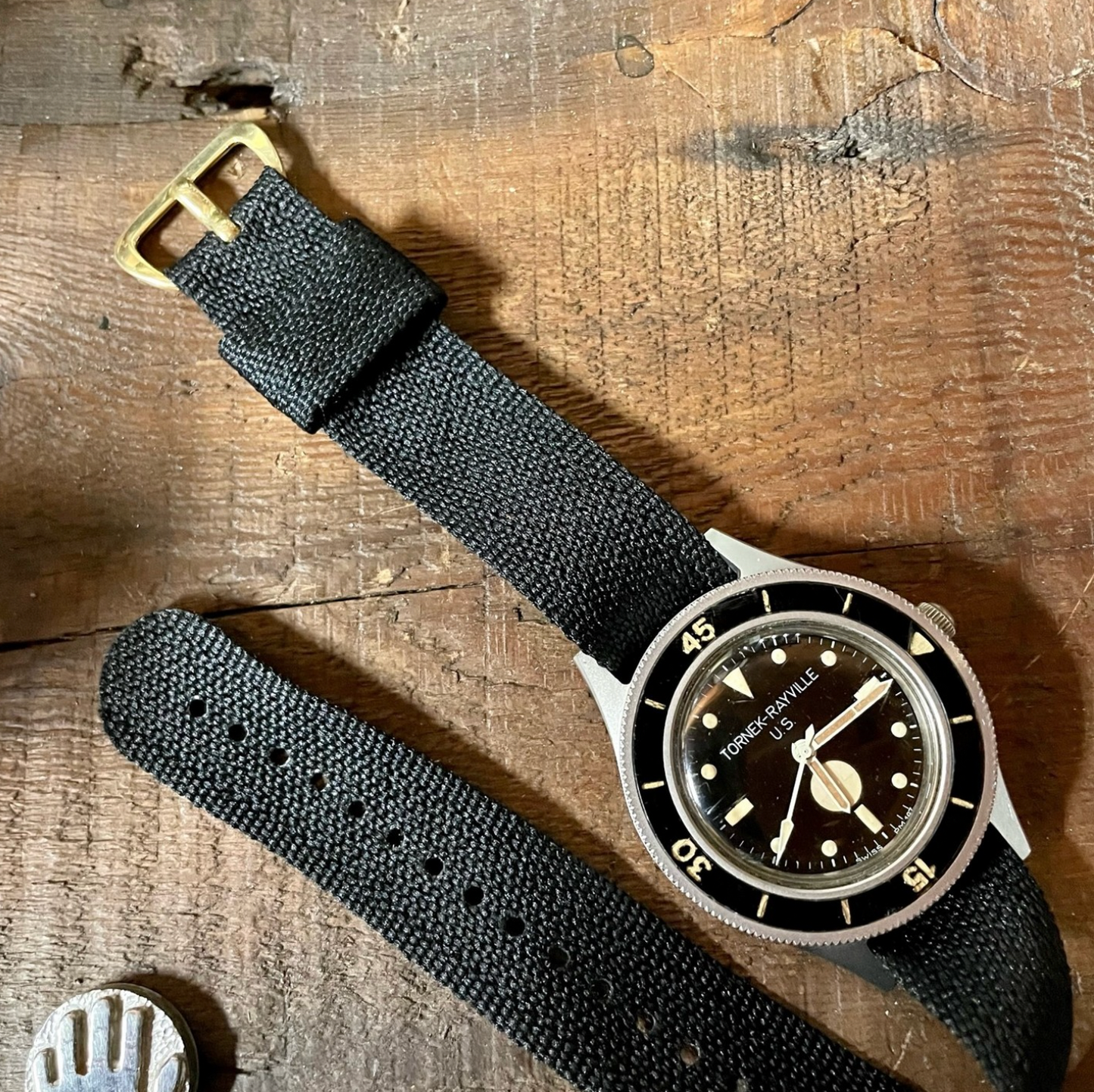THE BIRTH OF THE NATO WATCH STRAP – A HISTORY OF THE NATO STRAP AND POST WWII WATCHES

INTRODUCTION
In earlier posts the predecessors of the NATO watch strap were reviewed.
Some military watch specifications were in the process of revision after some years of experience in the field, and the the need for more advanced watches was revealed.
The W.W.W. watch for the British army was a revision to the ATP watch, released at the end of WWII, and surplus watches were de-stocked back into the civilian market. Advanced navigation and dive watches were being planned and were specified after the end of the war.
Also, after the end of WWII, political considerations led to the NATO military alliance, and all issued military equipment of members and associates of NATO, including watches, and straps, had an identifying NATO stock number (NSN).
One such NATO watch strap, more than the others, has had its NATO NSN shortened by common usage to just NATO.
THE NATO STOCK NUMBER
WWII revealed the need to coordinate the supply of military equipment, particularly when joint forces were in the field together.

The Vocabulary of Army Ordnance Stores (VAOS) was the British Army system of cataloguing parts. The Director of Stores maintained notes on all the in-service equipment and kept track of changes in patterns of equipment and stores. This list was updated and circulated on a regular basis. The Vocabulary publication, which in the later years of its use was amended quarterly, required that units use the exact nomenclature that appeared in the Vocabulary. The Vocabulary system was used by the British Army for close to ninety years until it started to be displaced by the NSN system in 1956.
With the formation of NATO in 1949, common numbering systems were developed for items of equipment. This system was based on the US Federal Stock Number (FSN), which itself commenced in 1953. In 1974 two additional digits were added (the national identifier), and in the US this became the National Stock Number.
In all 64 other NATO affiliated countries this number is referred to as the NATO Stock Number (NSN), and has 13-digits, the first four indicating the group and classification of similar supply military items. The next two digits correspond with the country code of NATO member states (12 is Germany, 99 is Great Britain, 00 or 01 is USA). The last seven digits describe the exact object.

The NSN, or NATO Stock Number is most easily explained in the above diagram. It commences with a NSC, and then a NCB, together with a 7 digit number.
The NSC for “Time Measuring Instruments” is 6645. The first two digits called the Federal Supply Group (FSG), define the overall category of the item. In the case of most issued watches, that is “66 – Instruments and Laboratory Equipment.” Adding the FSG to the next pair of digits – the 2-digit Federal Supply Class (FSC) – narrows the item category even more. For military watches, that becomes “6645 – Time Measuring Instruments.”
In the illustration above, the classification category code 1005 is “Guns, through 30mm”, 13 is Belgium, and the other non-significant numbers are meaningless.
Some 13 million items are identified with a NSN.
USMC KOREAN WAR WATCHES
(SPEC: WATCH, WRIST, 15-JEWEL AND 17-JEWEL)
The US Marine Corps sourced new watches in about 1949, which were very similar to the ORD DEPT watches of WWII. These included the Bulova 1917-H and the Hamilton 747. They were stainless steel, and the major external difference was the sub-seconds dial where the numerals were oriented horizontally. The end of the blued seconds hand was enhanced with a luminous ball. The specification for this watch is unknown, but there is a stock number, and ordnance drawing number for the Bulova.
The Buolva used a 15J 10BM movement.

Below is a Hamilton 747 on the right, with an ORD DEPT Hamilton on the left.
The case back reads USMC, OF-xxxxxx (the serial number). Later, more crudely some were additionally stamped MODEL 747, HAM or just 747. The inside case back is stamped with the case manufacturer, Keystone, Stainless Steel.

Image courtesy MWR forum user: Steve Z

The Hamilton 747 was issued from 1949 onwards, the complete assembly having part number 43011, and came with a strap, part number 43013. The strap drawing specification was B7646909.

Below is a similar dialed Bulova 1917-H in a stainless steel gunmetal or parkerised case, on the original strap.

Image courtesy MWR forum user: pittsjock
The gunmetal finish stainless case back is a screw-down design stamped “U.S. 1917-H.”
The mechanism has a domed metal dust cover for further protection. Removing this reveals the original manual wind (non-hack) mechanism, signed Bulova Watch Co., USA – 15 Jewels, 10BM.
The original inside case back is stamped STAR WATCH CASE CO., STAINLESS STEEL – xxxxxxx – 7197108. The first number is the watch serial number while the second number (7197108) is an ordnance number for the case back.
THE A-17 AND A-17A NAVIGATION
(SPEC; WATCH, WRIST; SECOND SETTING)
During WWII improvements were sought to the A-11 watch, and manufacturers produced some prototypes, as the improvements were largely dial related. As occurs often in product development, did the prototype proceed the specification? Nevertheless, MIL-W-6433 of 1950 describes the requirement for the A-17, with essentially much more luminosity, and a 24-hour dial when compared to the A-11.
Waltham produced the A-17, Watch, Wrist, Second setting, Navigation, Hack, from 1950 onwards, as shown below with a coin edge case back. Waltham made 3 lots of this watch, in 1950, 1952 and 1956. The watches made in 1952 and 1956 have the year as part of the serial number on the case back (eg AF52-xxxxx). Below is a 1950 production run case back.


Image flickr: Luke Davidson
The A-17 watch shown above is on an aftermarket strap.
A spare strap in a delivery box for a 1956 dated Waltham A-17 might give a clue to the type of strap originally used for this watch.
The date on the box is Nov 3 1961, and early batches of the Waltham A17 were produced in 1950.

The double loop continuous strap is most likely the original strap for the A-17, as this was the strap used for the A-11, and the strap below seems to have been on the watch for some time.

The Bulova and Elgin A-17A models were produced later to MIL-W-6433A of 1954 and overlapped, from approximately 1956 for the Elgin, and 1958 for the Bulova. An April 1957 model Elgin A-17A shown below was provided on the moulded nylon strap ORDNANCE DEPT. USA PART NO. 7646909, as specified in MIL-S-3035.

Image courtesy MWR forum user : Mr.D
THE RAF MK.11 WATCH
(SPEC. WRIST WATCH, MK.11, NAVIGATOR’S)
After the war, having used the USAF A-11 in the RAF 6B/234 designation, the UK MoD also independently modified the A-11, and issued the 6B/346 specification in late 1946 or early 1947.
The specification called for a watch which was very similar to the A-11. The main difference was that chronometer-grade performance was specified, along with anti-magnetic properties. (Type A-11 wristwatches were manufactured in accordance with military specification 94-27834, published in 1940).
The resulting watch, the 6B/346 Mk 11 “Navigator’s”, was produced by two companies, Jaeger-LeCoultre (JLC) and International Watch Company (IWC), and was issued to RAF and RAAF forces from 1948 to 1953. The JLC watch was not a success compared with the IWC watch.
The 6B/346 had fixed bars and originally came on a 17.5mm clip stainless steel BONKLIP bracelet (6B/2763). The RAAF models had spring-bars and were coded G6B/346. The BONKLIP strap could be closed at different positions which allowed it to be fixed at variable lengths, over or under a flying suit.
Every item of RAF equipment had a Store Ref. No. assigned, not only to the watch itself, 6B/346, but as well the BONKLIP straps. As three different versions of the BONKLIP were used by the RAF, namely 6B/2763 (17.5 mm in width designated to be used with the Mk 11, 6B/3224 (19.0mm in width) and 6B/3033 (20.0 mm in width). The last two to fit the chronograph 6B/551 H.S 9. and the Watch, Wrist, General Service 6645-99-910-1000 or 6B9101000.



D.R. Howlitt applied for and was granted the patent on the Bonklip strap in 1930 in both England GB349657 and later in Germany 577586 drawing above.
An American patent application US1779068A was earlier filed for virtually the same design on April 10, 1929, by Walter M. Krementz, but this Staybrite strap was expensive and not as popular as the Bonklip.

A 1933 advertisement for the Krementz band is shown below.

In Australia, in 1951 about 2000 replacement watch straps meeting US Military Specification, Strap, Wrist Watch, Nylon, MIL-S-3035 (dated 8 September 1949) were imported for the RAAF. Drawing B7646909 specified the one-piece moulded strap, shown below. With this type of strap, if one spring bar was lost, the watch would still remain on the wrist.

In 1954 a nylon NATO strap (6B/2617) was introduced by the RAF to replace the BONKLIP. As this band was very long, its length could be varied easily. However, the BONKLIP had advantages, and they were re-introduced by the RAF in 1956, allowing the BONKLIP or the nylon strap to be used alternatively. (Ref 1)

The 6B/2617 strap is a grey nylon strap with 8 longitudinal ribs. It was a 2 part strap with a keeper to retain the watch. It had welded seams and stainless steel hardware.

The 6B/2617 pre NATO strap, and the 6B/2763 Bonklip strap with 16mm wide links are shown above. The Bonklip strap fitted onto the fixed bars of the 6B/346 watch, and hence appears shorter.
A RAAF stores document refers to the nylon G6B/2617 strap – BAND WATCH WRIST NYLON

6B/2617 strap manufacturer reference Image Courtesy : Greg Steer.
Perhaps due to the distance involved the Manufacturer M Furst and Co of Treforest Pontypridd Wales has an incorrect address listed.
We now manufacture 16mm, 18mm and 20mm versions of the strap.

Photo credit : gary.stephen.pusey
THE DEF-3 SPECIFICATION, WATCHES AND STRAP
(SPEC: WATCH, WRIST, GENERAL SERVICE)
Ministry of Defence specification DEF-3 (provisional) dated 1 September 1951 was superseded by DEF-3-A dated 20 October 1959 for Wrist Watch, General Service for the British military. DEF-3-A stipulated the Joint Service Number or NSN 6645-99-910-1000 for central sweep (non hack) watches to this specification.
In the late 1940s and early 1950s a combined forces Working Party met 20 times, and produced a “provisional” Defence Specification No. 3 (DEF-3), General Specification for Wrist Watch, General Service, which was published on 1 September 1951.
The Omega 1953 (CK2777-1) purchased by the MoD for the RAF in 1953 was built to the DEF-3 specification. It uses the Omega 283 caliber. Below is the purchase order from 1952.

Image credit MWR forum user : jef33
The watch was to be issued on a DEF-3 strap. The specification for the strap is given below, and as shown below, it has no preformed holes for the buckle tongue.

Image courtesy MWR forum user: hq_sandman_ute

The case back of the Omega 1953 is shown above. The NATO Stock Number NSN was in its infancy and only 6645 101000 is engraved on the case back. The RAF stores reference code was 6B/542, and xxx/53 was the serial number.
Air Publication 1086, as late as 1966 lists the general service watch and the 6B/2594 strap as a spare.

The wider lugs of the Omega on the DEF-3 strap allowed the watch to slide off, and the DEF-3 strap was modified in service.
MWR forum member Jonah220 has posted the following recollection.
After training, in 1956 I was posted to Coastal Command, on Shackleton aircraft – 4 engine maritime patrol bombers. The Shack had a crew of 10 : 2 Pilots, 2 Navigators, 5 Signallers and a Flight Engineer. There was a requirement for the Pilots and Signallers to be issued with the black dialled General Service Omega 6B/542 watches, now known as the 53 Omegas (not the 56 Omegas). These were issued with Khaki webbing straps (not canvas, nylon, leather, or Bonklip). The webbing straps were, in format, the same as the current NATO straps, with the short extension and the 3 metal loops (not the DEF3 strap). I recall that these straps were not long enough to be folded back under the metal loop as on the modern NATO straps, and I assume that the length was the same as the DEF3 strap. During my time I never saw a 53 Omega with a leather strap or a Bonklip strap. I had 2 of these webbing ‘NATO type’ straps, the last in 1959.
The modified DEF-3 is shown below, a single thickness strap with a keeper. This strap was issued as the 6B/1242987.

Image courtesy MWR forum member : nickb
This strap is drawn, perhaps later, in Def Stan 66-4 (Part2) Issue 1 of April 11 1969, Watches Chronograph, wrist.

Photo courtesy MWR forum member geo7863

Photo courtesy MWR forum member geo7863
Feeding into the above Working Party, Smiths were contracted to produce a General Service wristwatch for issue to the British Armed Forces. The British government was concerned about the reliance on overseas supply of wristwatches, which had been an issue during the second world war and enticed Smiths to foster British manufacture of wristwatches.
These watches were based on the DEF-3 specification, and were given the same 6B/542 stores reference as the Omega navigators watch, also based on the DEF-3 specification, so we can assume were issued to RAF pilots and navigators. This makes some sense for a test order – the inside of a plane cockpit was a fairly harsh environment for a mechanical wristwatch due to the presence of electromagnetic fields. The watches were shielded from electromagnetic interference by an iron dial and mumetal dust cover, which formed an effective Faraday cage to prevent electromagnetic disturbance.
For whatever reason the Air Ministry decided not to proceed with extending the order and Smiths didn’t receive a military supply contract until the late 1960s for the W10 model. (Still earlier Smiths had provided a 6B/159 watch, which appears only to have reached prototype stage).

This is a Smiths General Service (GS) wristwatch which was issued in 1956. This is the rarest Smiths British military watch and arguably one of the rarest British military watches of all. Photo Credit : Mr. Jones Watches.
There were approximately 300 of these watches made up and issued to the RAF in 1954, 1955 and 1956, presumably as a test order.
The watch above is fitted with a recreation of the original A.F.0210. strap, a precursor to the ubiquitous NATO strap which is found on Military watches.
However, in 1954 the Air Ministry issued the 6B/2617 strap with a keeper loop. One of the hardest to find military straps is this pre NATO strap from the 1950’s. This strap which was used on the Mk.11 navigators watch, the 6B/346, has generally eluded collectors and is the early NATO grandfather strap in grey ribbed nylon, 5/8″ or 16mm wide.

The RAF GS Smiths Deluxe had the caseback marked with 6B/542 or 6b/542 designation, and NSN 6645 101000. The Directorate of Overseas Surveys (D.O.S.) GS Smiths DeLuxe Cal 27CS caseback of 1959 or so, has D.O.S. and the full NSN 6645-99-910-1000 engraved.
Here is a Smiths Deluxe GS watch on a period VB Hygienique NATO strap.

Image courtesy MWR forum user : Revo

And a 6B/542 version on a homage AF0210 strap with fabric keeper, a style which predated the NATO strap.
The Smiths Deluxe GS watch 0434E version of the Cal. 27CS is shown below on the cover of the Smiths manual on a woven nylon NATO strap. This strap is the 6B/2617 strap.

In 1965 Hamilton provided a general service watch to the RAF. This was supplied under DEF-3-A and was non hackable. The watch was built to a similar specification to the Mk.11 watch and is sometimes called the Hamilton Mk.XI. The watch is 6B-9101000.
The image below shows the watch and a sewn webbing strap.

DEF-3-B dated September 1966 covered hackable central sweep watches to this specification, and stipulated the Joint Service Number or NSN 6645-99-961-4045. The B revision required “inclusion of a device to arrest and release the second hand”.
The General Service Smiths W10/6645-99-961-4045 (model GS4701) was issued from 1967 to 1971 under DEF-3-B, and used the DEF-3 strap. The RAF version was engraved 6B-9614045. Hamilton also made a model 6B-9614045 H-67.

Drawing 377-5: Image courtesy MWR forum user : hq_sandman_ute
The DEF-3 strap below has a rounded, rectangular stainless steel buckle as in the drawing above.

Image courtesy MWR forum user : hq_sandman_ute


6B/2594 STRAP IMPRINT
MRW forum user geo7863 has confirmed that the DEF-3 strap was designated by the RAF as a 6B/2594 strap, and was initially used on the 6B/2593 wrist compass, before being replaced by a long sewn in place strap. Top image courtesy geo7863.
A long strap with similar weave has been seen with an Omega stamp, but details of this are missing.


A Hamilton watch on an earlier DEF-3 strap is shown below, with the characteristic doped tip. The buckle and keepers are stainless steel, but this buckle is shouldered, like that of the A.F.0210. strap. Earlier buckles were square shouldered, and these and the keepers were brass, and the later buckles were rounded wire stainless steel, as in the drawing. The webbing is tropicalised to specification NF203/7, and the buckle tongue penetrates the NATO watch strap to make the positioning hole.

Commonly the older A.F.0210. webbing strap was used. This was part of the revised 1944 or 44 pattern webbing issued as A6/AFxxxx, Jungle Equipment, for use in the far east. The A.F.0210. strap was a precursor to the DEF-3 strap above, with almost identical dimensions, but used folded webbing stitched all round, with a square end, and brass buckle and keepers. The A.F.0210. strap and DEF-3 strap sometimes had virtually identical hardware, but the latter in stainless steel, not brass.

When the 44 pattern Jungle Equipment was introduced in 1945, a lightweight aluminium frame that could be configured to carry various loads was one of the many new innovations. The complete frame was AF0034, Carrier, Manpack, General Service, and weighed 1.7kg. Instructions for use are shown above, together with the AF0210 strap and a 6B/2593 compass.
The various components of the AF0034 manpack carrier were given stores numbers to allow for replacement components. The ladder frame is reference AF0083, and the removable load board is AF0084. The four bearer tension straps (marked AF0087) provide a large cushioned area for comfort. The waist NATO watch strap is marked AF0088. Frame brace straps are AF0086. The manpack carrier also has two simple shoulder straps with wider shoulder sections for comfort and attached to these is a chest strap to help secure the load. The shoulder straps are stamped with AF0091. The two part chest strap is AF0085. The reverse of the manpack carrier has two adjustable straps with 44 pattern style double buckle fasteners for securing loads to the frame, labelled AF0090. The fastenings are all in the same rust proof metal as used in the 44 pattern webbing set.
Below is an A.F.0210. strap with a 6B/2593 compass, and a A.F.0225 rectangular mess tin. The mess tin is also marked MMS1945 and is also part of the 44 pattern webbing jungle system, A.F.xxxx issued in 1945.

Below is a mint A.F.2010. strap with an A.T.P. Revue 59 watch.
 Image courtesy MWR forum user: Shane Reed
Image courtesy MWR forum user: Shane Reed
As earlier VAOS nomenclature for military equipment was reclassified under the NSN system the A.F.0210. strap finished it’s service life under NSN W10/6645-99-910-1003, Webbing, (Spec : STRAP, WRIST, INSTRUM).
W10 is the section of the Vocabulary of Army Ordnance Stores that includes magnetic compasses, drawing and optical instruments, watches, survey, hydrographic survey and underwater sound equipment.
Later A.F.0210. buckles and loops were selenium dioxide treated to make black (bonderised?).

Image courtesy: anchorsupplies.com
A service life of some 35 years makes this a classic NATO watch strap, and the influence which it had on the design of the NATO strap can be seen in the similarity in design of the NATO watch strap below.
The nylon NATO strap, seen earlier as 6B/2617 was specified by the military from at least 1973 onwards, under under NSN 6645-99-124-2986. It is 280mm long, compared with the A.F.0210. which was only 250mm long, with the design change acknowledging that wrists were becoming larger.
Despite predating the DEF-3 strap, and the NATO strap, the A.F.0210. strap was not discontinued, and remained in service alongside the DEF-3 strap, and the NATO strap, until taken out of service in February 1980. Below is the order replacing it with the NATO NSN 6645-99-124-2986 (Nylon).

Below is a NOS Smiths W10 and the NOS A.F.0210. strap which came in the box with the Smiths W10. The box reads W10/6645-99-961-4045. The strap is W10/6645-99-910-1003.


Image courtesy MWR forum user: MBRADIO

The Smiths catalogue from 1968 shows the watch on a braided nylon strap.
Image courtesy MWR forum user : simonk
THE BULOVA GENERAL SERVICE
(SPEC : WATCHES, WRIST (ALL GRADES))
Bulova provided the A-17a navigation watch above, and also similar general service watches to the MIL-W-3818A specification. The MIL-W-3818A specification covered 3 grades of GS watches, Grade I +/- 10 sec/ day, Grade II +/- 30 sec/ day, and Grade III +/- 60 sec/ day
The MIL-W-3818 specification of 24 October 1952 was revised to the MIL-W-3818A specification dated 12 March 1956. Figures 1 and 2 of the specification provide for a sub-second, and sweep the second dial respectively.
Bulova provided two sweep second watches to the MIL-W-3818A specification with a 10BNCH movement, a 12 hour to Figure 2a, and a 24 hour to Figure 2b. The 24 hour dial is very similar to the A-17a dial, but the hour hand is heavy spade-shaped. The watch strap was specified to be MIL-S-3035 Strap, Wrist Watch, Nylon of 8 September 1949.
The Specification called for the strap to be assembled to the completed watch prior to shipment.

Photo Courtesy MWR forum member hq_sandman_ute
A NOS cordovan watch strap is shown below with a Bulova MIL-W-3818A.

Image courtesy Omega Forum user: Dre
MIL-S-3035 Strap, Wrist Watch, Nylon reads in clause 3.3 :
3.3 Design and Construction – The watch strap shall be manufactured in accordance with Drawing B7646909. It shall be of one-piece construction with integrally moulded loops. Sewing, cementing or heat sealing shall not be used in the construction of the strap.

The NATO watch strap came in black or Cordovan/brown.
MIL-W-3818B specification dated 17 October 1962 revised the title to Watch, Wrist : DTU-2A/P and revised the dial, and the strap requirement.
Clause 3.8 reads :
3.8 Strap. The strap shall be fabricated in accordance with Drawing C 8636227.
However, an interim amendment of 12 January 1966 substituted :
3.8 Strap. The strap shall be Type II as specified in MIL-S-46383. The color of the strap shall be black.
Benrus provided these MIL-W-3818B specification watches to the military.
Perhaps due to the rigid nature of the MIL-S-3035 straps, many MIL-W-3818A watches are seen on MIL-S-60127 straps.

Above is a Bulova MIL-W-3818A 12 hour dial on a MIL-S-60127 strap. Image courtesy MWR forum user : shepcs
The watch above has the 12 hour dial and is stock number 6645-542-0554 (NSN 6645-00-542-0554), and the 24 hour dial is 6645-808-1407 (NSN 6645-00-808-1407).
Hamilton and Elgin also provided a big crown Grade II watches under this specification MIL-W-3818. The Elgin (Cal.805) with thicker numerals than the Bulova above. The Hamilton dial was signed.


Image courtesy MWR user: What Does Your Watch Say?

Image courtesy MWR user: siewming
These watches date to about 1957.
The BuShips canteen watch has a similar dial, and also has the correct NATO watch strap, marked ORDNANCE DEPT. USA PART NO. 7646909, as specified in MIL-S-3035 Strap, Wrist Watch, Nylon clause 3.3 :
The strap shall be manufactured in accordance with Drawing B7646909.


TORNEK-RAYVILLE, TR-900
(SPEC : MIL-W-22176A, MILITARY SPECIFICATION: WATCH, WRIST, SUBMERSIBLE (400-FOOT), NON-MAGNETIC)
MIL – W – 22176 A (SHIPS) of 24 March 1961 replaced MIL – W – 22176 (SHIPS) of 1 September 1959, and was for an amagnetic 400 foot deep capacity diver’s watch. The US Navy specification for submersible watches was strict and only one manufacturer could meet the requirements
Allen Tornek, who was then importing pieces from the Rayville Watch Company who were already manufacturing a diver’s watch, the Blancpain ‘Fifty Fathoms’ bid for the contract, and produced the Tournek-Rayville.
Only 1000 watches were produced, and many have been destroyed as radioactive waste, so maybe only 20 to 30 currently survive.
The MIL – W – 22176 A (SHIPS) specification required :
3.9 Strap – Each watch supplied under this specification shall be equipped with a one-piece nylon strap conforming to the specification MIL-S-21382, and which has met the magnetic test requirement of that specification.

Above is the dial diagram included in the MIL-W-22176A specification requirements (left), and the Tornek-Rayville instruction manual, showing the proposed light grey ribbed nylon strap (right).
The watches are commonly referred to as “Tornek-Rayville”, “TR-900” or sometimes just as “Tornek”, as these are the markings seen on the dial and on the movement. The initial order delivered to the US Navy was for 780 pieces in 1964 and another in 1965 for 300 pieces giving a total of just over a thousand for this model.
The 11 ribbed as-issued ribbed weave RAF style watch strap is shown below.

MIL-S-21382(SHIPS) is for STRAP, WRIST INSTRUMENT, WOVEN NYLON and was issued on 21 August 1958.
The specification requirements were for an 11 inch, light grey herringbone weave nylon strap, with an 1/2 inch wide keeper of the same material fused to the watch strap. Also, “the buckle shall have a dull nonreflecting finish and be free from burrs.”
In 1963, before the first watches were supplied, MIL-S-21382(SHIPS), was subsumed into MIL-S-46383, STRAP, WRIST: INSTRUMENT of 20 July 1963. The strap became the Type I – Strap, Special Purpose: Non-Magnetic Buckle of the 46383 series of specification issues.
The strap colour grey changed to black with the specification change, and the webbing keeper to the same width as the strap (see Note 5).

Above is the Type I special purpose strap drawing from MIL-S-46383. The dimensions are as for the MIL-S-21382 specification strap, and the length allows the watch to be worn over a diving suit.
THE NATO WATCH STRAP NSN 6645-99-124-2986
(SPEC : STRAP, WRIST WATCH)
The nylon NATO watch strap, seen earlier as 6B/2617, as specified by the military from at least 1968 onwards, under NSN 6645-99-124-2986, and from 1992 there are actually two NATO stock numbers allocated to this item: Army/Navy NSN 6645-99-124-2986 and RAF NSN 6645-99-527-7059.

Image courtesy MWR member : Flashharry62
Through common usage, the full NATO NSN 6645-99-124-2986 for this strap is abbreviated to just NATO strap.
Def Stan 66-4 (Part1) Issue 2 of 1 January 1971 describes Watches, Wrist, Divers’.

In Paragraph 11 it states:

Figure 2 is a drawing of the strap codified to NSN 6645-99-124-2986. The colour is specified as Steel Grey. Strap width is 18.5mm straight cross weave nylon, and the joints are welded. Hardware is brass to BS816, chrome plated.
This strap was also specified in Def Stan 66-4 (Part1) Issue 1 of 30 August 1968.
The drawing below draws heavily on the dimensions of the 1954 6B/2617 strap, as all dimensions are identical except for the width.

The current Defence Standard specification illustrates very similar requirements for this NATO watch strap. It was specified in more detail in Def Stan 66-15 (Part 1) Issue 1 – Strap (Nylon) dated 30 November 1973.

The commonly called NATO strap has several written characteristics, and probably many more unwritten characteristics.
The current military specification strap comes in only one colour (Admiralty Grey) and one width (20mm). The hardware specification is chrome plated brass with a recessed buckle to receive the tongue. Length 280mm, width 20mm, thickness 1.2mm.
It is currently defined in Ministry of Defence, Defence Standard 66-47 as Strap,Wrist Watch.

Earlier, there was a nearly identical NATO style strap (narrower) made in accordance with DEF STAN 66-15 (PART 1) Issue 1, Strap (Nylon), 30 November 1973. It was specified as grey as well, and it was used (under NSN 6645-99-124-2986) by the Royal Navy and British Army from 1973 until 1992 when the NATO standard DEF STAN 66-47 (ISSUE 1) superseded it.
For soldiers to obtain a NATO strap, they had to fill out a form known as the G1098, or G10 for short. Sometimes these straps are known as G10 straps, as they were used on W10 watches.
US MILITARY NSN 6645-00-333-5396
(SPEC: STRAP, WRIST: INSTRUMENT)
By contrast, the US Military NSN 6645-00-333-5396 Strap, Wrist Instrument; Plastic Polyamide, is just a pass through strap, manufactured according to military specification MIL-S-46383B Type II.
MIL-S-46383A Strap, Wrist: Instrument was issued on 1 June 1965, and superseded by MIL-S-46383B on 16 September 1970.

This requires a black strap with a buckle assembly which shall be black oxide coated and painted with a dull black enamel finish. The watch strap is of one-piece construction 9.750 inches long, 0.75 inches wide and 0.045 inches thick. The strap has a keeper loop to receive the strap end as shown below. The specification allows for other colours than black to be procured.
US MILITARY NSN 6645-00-965-1488
(SPEC: STRAP, WRIST: INSTRUMENT)
This NATO stock number was created on 1 January 1960.
MIL-W-46374 specification was issued in October 1964 to procure a low cost, disposable alternative to the MIL-W-3818B. The specification provided for either metal or plastic sealed cased watches with minimal shock or water protection, and a lower accuracy, and a non-hacking movement. Specifically, the watch strap was to be olive drab.
3.3.5 Strap. – The strap shall conform to the requirements of MIL-S-60127.
This Specification was later revised, and required fixed bars, and an olive drab pass through strap, manufactured according to military specification MIL-S-46383B Type II.
The MIL-S-46383 strap came in three types
Type I – Strap, Special Purpose; Non-Magnetic Buckle [3/4 inch wide]
Type II – Strap, General Purpose [5/8 inch wide]
Type III – Strap, General Purpose [3/4 inch wide]
3.2.4.6 Strap. – The strap shall be in accordance with MIL-S-46383, Type II. The color of the strap shall be olive drab matching color number X34087 of FED-STD-595.
A NOS strap is shown below

The stock number was allocated 6645-965-1488 shown here in the October 1965 NOS batch pictured above.

Other stock labels existed.

The buckle was stainless steel with a matt, non reflective finish. Later buckles were blackened.


By 1974, black versions of the strap were available. Shown on a Benrus GG-W-113 field watch from December 1970

THE 7A28-7120 GEN. 1 RAF
In the mid 1980s, Seiko released its 7A28-7120 variant with reference number SPR047 and NATO Stock Number (NSN) 6645-99-768-3056 to be used by the Royal Air Force (RAF).
The MoD bought and issued a total of 11,307 these Gen 1’s, which makes it one of the most popular issued military chronographs to date.
It should seem obvious that NSN 6645-99-768-3056 (Chronograph, Wrist ) should be compatible with NSN 6645-99-527-7059 (Strap, Nylon/Leather, Wrist Watch).

Image courtesy of Ned Frederick of earthlink.net
Here is such a combination.
The strap is shown below.

Image courtesy of MWR member : synthpunk
NSN 6645-99-527-7059 (Strap,Nylon/Leather,Wrist Watch DEF STAN 66-15 (PART 2)) illustrates the Specification for a brown RAF strap. This is the Kitchener style strap from WWI.

These brown combination leather straps were the standard RAF strap from the early 1970’s until the 1992. Therefore, a properly dressed Gen 1. RAF Seiko Chrononometer should sport one of these rare Kitchener NATO straps.
VARIATIONS TO THE STRAP, WRIST WATCH SPECIFICATION
From the earliest time at which men fought in organised companies, the corps have possessed some sort of insignia visible over all the field of battle, serving as a rallying point for the men of the corps and as an indication of the position of the leaders.
All military Regiments have had ribbon and patch colours based on their battle flag or colours.

Variations in colour for one piece nylon and NATO straps derived from another military tradition, that of stable belts.
Originally, stable belts were worn by the cavalry in the working dress they used for stable duties, but in the 1950s they spread to all branches of the armed forces, adding a splash of colour and individuality to the khaki working uniforms. Initially they were resisted by many senior officers, who saw them as too individualistic, but due to Regimental rivalry they soon became accepted throughout the forces.
As an example, the Royal Marines stable belt is shown below.
This is worn over the barracks dress jacket.

The NSN for a stable belt is simply NSN: 8440-99-571-2693 Belt. However military uniform suppliers soon produced Regimental stable belts.
When worn without the jacket, but with NSN 8405-99-983-1241 Trousers, Mans, Barracks Dress,Army All Ranks, khaki it is worn through the belt loops.
The availability of woven nylon in various colours soon led to British Military Regiments ordering NATO straps in regimental colours, again from specialty outfitters.

Above is the Royal Marines NATO strap on a NSN 6645-99-541-5317 Watch, Wrist.
James Bond, in Goldfinger, 1964 wore a RAF type nylon strap on his Rolex “Big Crown” Ref. 6538 Submariner, in alternating navy blue and olive stripes separated by a thin burgundy line. Here is a recreation, it can be seen that the NATO watch strap is only 16mm wide, as was common at the time for military watches, and does not fit the lugs of the Rolex.


Today, every Regiment of the British Army has its own stable belt, together with its own NATO strap, often very colourful, to go with the regimental tie (NSN 84440-99-874-6348 Tie, Regulation)
REFERENCES
Ref 1 ‘Man is Not Lost’ – an Account of the Mk 11 Navigational Wristwatch Matthias Christian, Thomas Koenig and Greg Steer. Horological Journal January 2004. pp 9-14.

